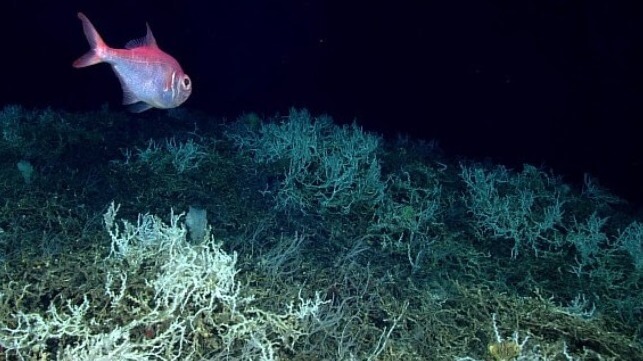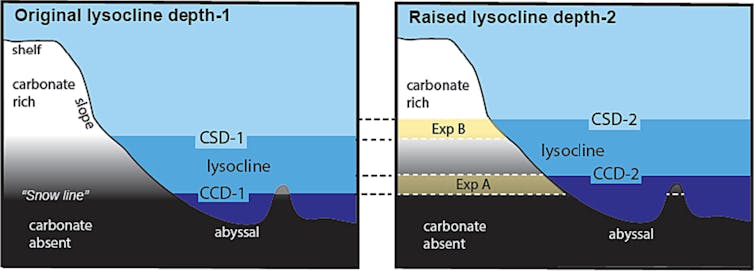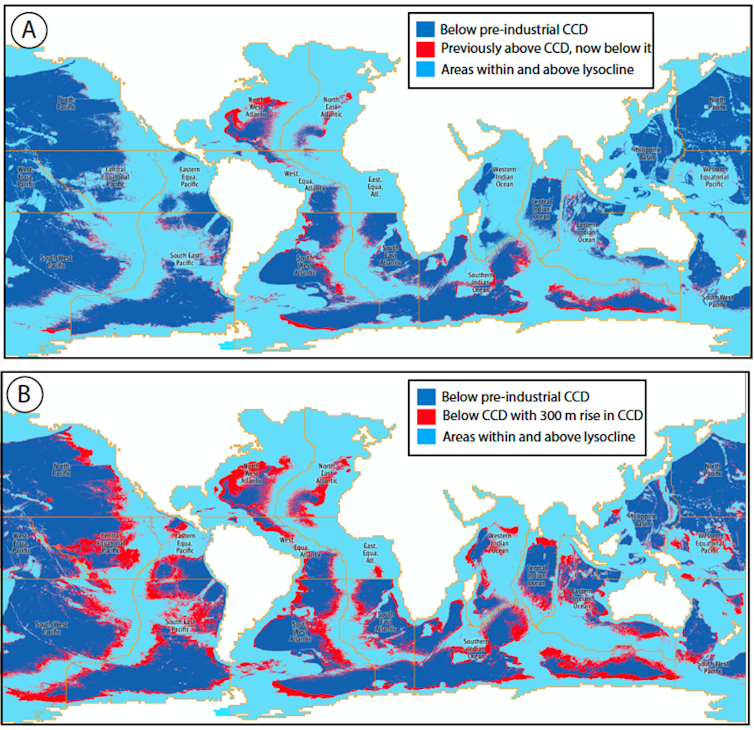Acidification Will Put 10% of Seabed Off-Limits for Creatures With Shells

[By Mark John Costello and Peter Townsend Harris]
In the deepest parts of the ocean, below 4,000 meters, the combination of high pressure and low temperature creates conditions that dissolve calcium carbonate, the material marine animals use to make their shells.
This zone is known as the carbonate compensation depth – and it is expanding.
This contrasts with the widely discussed ocean acidification of surface waters due to the ocean absorbing carbon dioxide from the burning of fossil fuels.
But the two are linked: because of rising concentrations of carbon dioxide in the ocean, its pH is decreasing (becoming more acidic), and the deep-sea area in which calcium carbonate dissolves is growing, from the seafloor up.
The transition zone within which calcium carbonate increasingly becomes chemically unstable and begins to dissolve is called the lysocline. Because the ocean seabed is relatively flat, even a rise of the lysocline by a few meters can rapidly lead to large under-saturated (acidic) areas.
Our research showed this zone has already risen by nearly 100 meters since pre-industrial times and will likely rise further by several hundreds of meters this century.
Millions of square kilometers of ocean floor will potentially undergo a rapid transition whereby calcareous sediment will become chemically unstable and dissolve.
Expanding boundaries
The upper limit of the lysocline transition zone is known as the calcite saturation depth, above which seabed sediments are rich in calcium carbonate and ocean water is supersaturated with it. The calcite compensation depth is its lower limit, below which seabed sediments contain little or no carbonate minerals.

The carbonate content of seafloor sediments decreases within the lysocline, reaching zero below the carbonate compensation depth (CCD). Above the lysocline is the calcite saturation depth (CSD), with seabed sediments rich in calcium carbonate. Author provided, CC BY-SA
The area below the calcite compensation depth varies greatly between different sectors of the oceans. It already occupies about 41% of the global ocean. Since the industrial revolution, this zone has risen for all parts of the ocean, varying from almost no rise in the western Indian Ocean to more than 300 meters in the northwest Atlantic.
If the calcite compensation depth rises by a further 300 meters, the area of seafloor below it will increase by 10% to occupy 51% of the global ocean.

These maps show the changes in area of ocean exposed to corrosive bottom waters in 17 different regions. The pre-industrial CCD is dark blue and areas above the lysocline are light blue. Map A shows the present day and map B shows a lysocline rise of 300 meters. Author provided, CC BY-SA
Distinct habitats
For the first time, a recent study showed the calcite compensation depth is a biological boundary with distinct habitats above and below it. In the northeast Pacific, the most abundant seabed organisms above the calcite compensation depth are soft corals, brittle stars, mussels, sea snails, chitons and bryozoans, all of which have calcified shells or skeletons.
However, below the calcite compensation depth, sea anemones, sea cucumbers and octopus are more abundant. This under-saturated (more acidic) habitat already limits life in 141 million square kilometers of the ocean and could expand by another 35 million square kilometers (13.5 million square miles) if the calcite compensation depth were to rise by 300 meters.
In addition to the expansion of the calcite compensation depth, parts of the ocean in low latitudes are losing species because the water is getting too warm and oxygen levels are declining, both also due to climate change.
Thus, the most liveable habitat space for marine species is shrinking from the bottom (rising calcite compensation depth) and the top (warming).
Island nations most affected
The exclusive economic zones of some countries will be more affected than others. Generally, oceanic and island nations lose more, while countries with large continental shelves lose proportionately less.
Bermuda’s EEZ is predicted to be the most affected by a 300-meter rise of the calcite compensation depth above the present level, with 68% of that country’s seabed becoming submerged below the lysocline. In contrast, only 6% of the US EEZ and 0.39% of the Russian EEZ are predicted to be impacted.
From a global perspective, it is remarkable that already 41% of the deep sea is effectively acidic, that half may be by the end of the century, and that the first study showing its effects of marine life was only published in the past year.
Mark John Costello is a Professor in Marine Biology, Nord University.
Peter Townsend Harris is a Adjunct Professor in Marine Geology, University of Tasmania.
This article appears courtesy of The Conversation and may be found in its original form here.
https://images.theconversation.com/files/574763/original/file-20240210-16-8shcrc.png?ixlib=rb-4.1.0&q=45&auto=format&w=754&h=730&fit=crop&dpr=1
The opinions expressed herein are the author's and not necessarily those of The Maritime Executive.
No comments:
Post a Comment